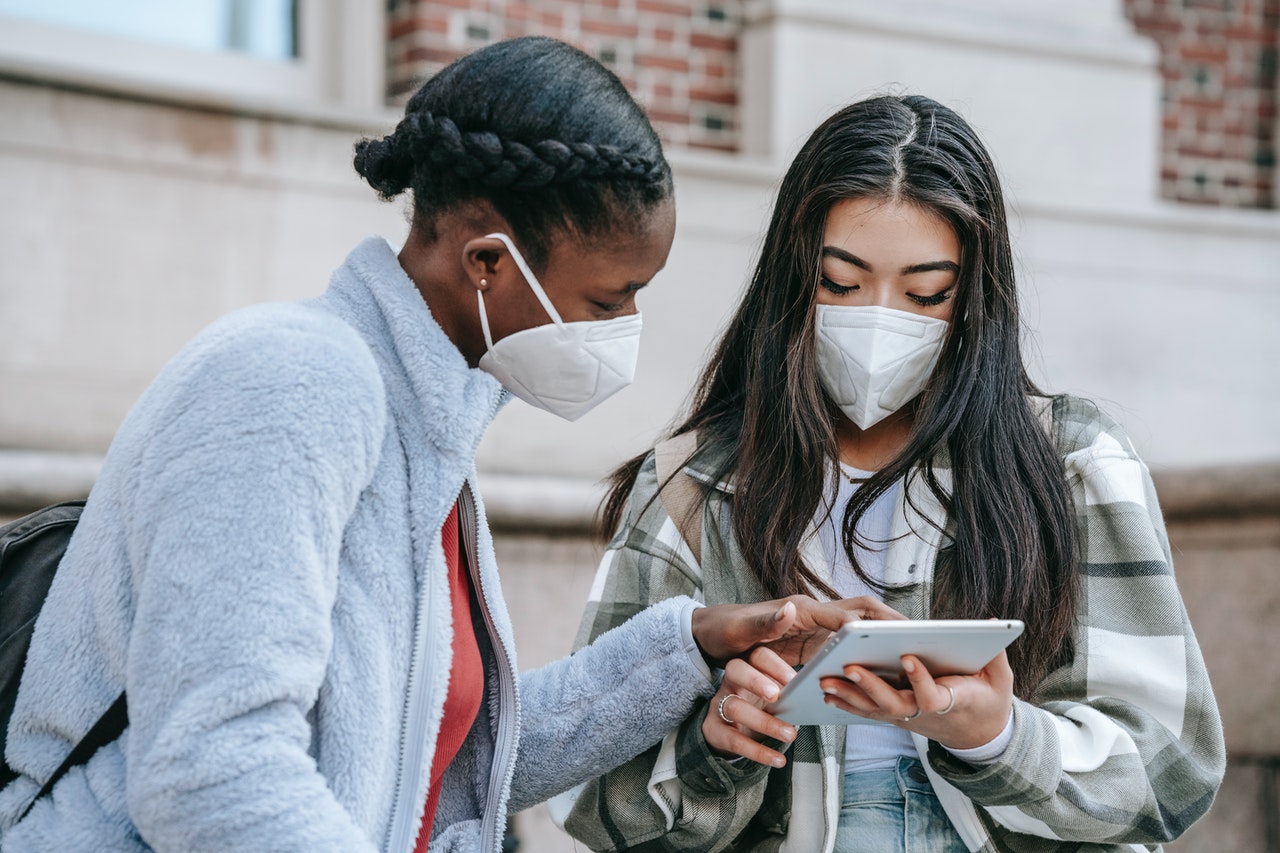[ad_1]
BALTIMORE — Zia Hellman ready to welcome her kindergarten college students again to Walter P. Carter Elementary/Center College this month the best way any instructor would on the primary day of faculty: She fussed over her classroom.
Ms. Hellman, 26, dodged across the triangular desks, spaced six ft aside and taped off in blue containers. She fretted concerning the blandness of the partitions, fumbled with the plastic dividers protecting identify tags and organized the person yoga mats that changed colourful carpets. Each window was open for further air flow, chilling the air.
“I ponder how they’re going to react to all of this,” she stated, arms on her hips, scanning the room for the final time. “I don’t know what I’m alleged to really feel, however it feels proper.”
Ms. Hellman was amongst about two dozen academics and workers members required to return to work on Nov. 16 for the primary in-person instruction in Baltimore Metropolis Public Colleges since March. Town was the primary giant college district in Maryland and the newest amongst city districts within the nation to tiptoe into one of many highest-stakes experiments within the historical past of the nation’s public training system: educating face-to-face in a pandemic.
Returning to the classroom has not been straightforward; neither has distant studying.
Educators trying to get again in entrance of scholars have needed to navigate conflicting steerage from politicians and public well being officers. Some academics’ unions have refused to return to buildings till the virus abates, ostracizing colleagues who dare break with them. However, the nation’s most weak kids have sustained extreme tutorial and social hurt from the remote-learning experiment. Mother and father, navigating their very own financial and work struggles, are more and more determined.
Ms. Hellman has yearned to be again in her college constructing in northeast Baltimore since September. She additionally understands the dangers.
“I really feel like I’m a bit in ‘The Starvation Video games,’” Ms. Hellman stated. “I didn’t volunteer as tribute, I used to be chosen as tribute. However I wish to be right here for my college students.”
Superintendents, meantime, have needed to navigate a firestorm of political stress, parental choice and the burden of a once-in-a lifetime public well being disaster.
“Superintendents have at all times needed to cope with conflicting pursuits, however it’s by no means been this type of life-and-death steadiness,” stated Michael Casserly, the chief director of the Council of the Nice Metropolis Colleges, a coalition of enormous, city, public college methods throughout the nation. “To have pursuits and choices altering week to week, everyday, makes this example in contrast to something public training has ever confronted.”
For Sonja Santelises, the chief government officer of Baltimore Metropolis Public Colleges, the choice to reopen 27 colleges on Nov. 16 to about 1,200 academically at-risk college students — comparable to kindergartners, particular training college students and English-language learners — final week was not a alternative however an obligation. She made the decision on the recommendation of town’s public well being commissioner.
“If I have been to cling to one-liners or search to attain political factors like some individuals need, I’d select to not see these households who want choices, who want translators, these refugee households who walked miles to get their kids an training,” Ms. Santelises stated. “I cannot do this.”
Baltimore lowered the variety of deliberate constructing reopenings to 27 from 44 because the virus surged in sure elements of town. However the native academics’ union is calling for buildings in Ms. Santelises’s district to remain closed till they’re deemed completely protected or a vaccine is broadly obtainable. It has pressured particular person academics in opposition to volunteering to return and inspired mother and father to boycott.
These tensions reverberate throughout the nation, the place colleges are grappling with the pandemic in broadly various methods, with some closing this month after opening earlier this fall at the same time as others like in Baltimore simply now are attempting to reopen.
“We’re not simply being obstructionist; we’re obstructing the district from placing individuals’s lives in danger,” stated Diamonté Brown, the president of the Baltimore Lecturers Union.
Greater than 70,000 schoolchildren left Baltimore lecture rooms in March, when the coronavirus outbreak in the US was declared a pandemic. Since then, college leaders have targeted on non permanent measures. They purchased computer systems and internet-access units, despatched worksheets to college students’ houses, staffed their cafeterias and buses to serve meals to their communities, and waited for course from native and federal well being officers that by no means actually got here.
However now, with the pandemic threatening to derail the training and prospects of a era of youngsters, district leaders are feeling stress to maneuver on their very own.
In Washington, D.C., inside testing information exhibits steep declines within the variety of kindergartners by second grade college students assembly literacy benchmarks, The Washington Publish reported. In Houston, big numbers of middle- and high-school college students are failing their first semester, based on The Houston Chronicle. Even prosperous, high-performing districts like Fairfax County, Va., a Washington suburb, are reporting alarming charges of center and highschool college students failing lessons, significantly English-language learners and college students with disabilities — two populations {that a} latest Authorities Accountability Workplace report discovered have been poorly served by distant studying.
Among the many most alarming statistics are the numerous enrollment declines that districts throughout the nation are experiencing, significantly amongst kindergartners. Public training is out of attain for some households with out web entry or with dwelling lives which are unconducive to distant leaning. Some households have merely given up.
Table of Contents
‘My Masks Is on My Face’
Ms. Hellman, in her fourth yr of educating kindergarten, understood what returning to the classroom would imply. She wouldn’t have the ability to see her 92-year-old grandmother. She could be topic to “corona-shaming” by colleagues, household and mates who’ve stayed away from work. She was placing herself personally in danger.
However, she reasoned, “I’m younger, I’m wholesome.”
At 9:15 a.m., every of the six college students whose households had opted for in-person studying in her classroom bought temperature checks. Two minutes later, one scholar was excitedly holding his masks as much as present her its design.
“I like your masks,” Ms. Hellman instructed him, “however I feel it could be cuter on.”
At 9:30, all the scholars have been allowed to take away their masks to snack on Cinnamon Toast Crunch and applesauce. “It’s solely 10 minutes,” she instructed them and herself, “and the home windows are open.”
By 10:30, issues had settled down, and he or she was only a instructor. College students have been practising writing their letters. By 11 a.m., they have been getting ready for recess by singing to the tune of “The Farmer within the Dell”:
My masks is on my face.
My masks is on my face.
Masks hold you and me protected.
My masks is on my face.
“The aim of the primary day is to feed them, have enjoyable and ship them dwelling,” Ms. Hellman stated. “We’d like them to return again the following day.”
Not solely did her six in-class college students return that subsequent day, however so did 19 of her college students studying just about. So did Brandon Pinkney, the college’s principal, who was displaying her classroom to a father or mother who was contemplating sending her son again.
Within the 24 hours since in-person lessons resumed, Mr. Pinkney was fielding inquiries from mother and father intrigued by what they have been seeing within the classroom by their kids’s pc screens at dwelling.
He canvassed the constructing, popping his head into totally different lecture rooms and mentally reconfiguring the areas, simply in case. He hoped to order an additional desk for a scholar who instructed him bluntly that he was accomplished with “that digital stuff” however would return if the college reopened.
“I do know he’s within the streets,” Mr. Pinkney stated. “If I don’t see him this week, I’m going to get him.”
Many workers members within the college stated they’d solely returned to the constructing as a result of it was Mr. Pinkney’s voice on the road, telling them that they’d been chosen.
He promised transparency and assist, and that was sufficient for Rachael Charles. A special-education instructor with two youngsters at dwelling, she wasn’t as straightforward to steer as Ms. Hellman, who acknowledged that as a younger, childless instructor, she didn’t face the identical alternative between her life and livelihood.
With the Black neighborhood disproportionately affected by the virus, Ms. Charles, who’s African-American, had been figuring out over the summer time, taking nutritional vitamins and alkaline water, simply in case. However she nonetheless explored taking a go away of absence.
“I like my college students dearly, however I’m coming again into the classroom to care for kids when nobody is taking good care of mine,” she stated.
Security dangers apart, Ms. Charles puzzled if she would have the ability to be the instructor that her college students remembered. “I’m very hands-on, and it’s laborious to have them proper in my attain and never assist them the best way they want,” she stated.
When a scholar with a slight bodily incapacity struggled to tug his masks right down to eat lunch, she initially stood outdoors his blue field, encouraging him. “Below your chin, you are able to do it.”
However earlier than lengthy, her hand was on his mouth, and he or she pulled it down herself.
Downstairs, Mr. Pinkney was in a hallway with a gaggle of clinicians debating whether or not to do digital or in-person particular training assessments.
“It doesn’t make sense to do them just about when we’ve got evaluation rooms right here,” he stated. “They’re cleaned each hour on the hour.”
“Each hour?” a skeptical voice might be heard asking over a speakerphone.
“On the hour,” a voice chimed in from close by.
That voice belonged to Donice Willis, the college custodian. A 66-year-old grandmother of 11, she had by no means stopped working through the pandemic, and he or she couldn’t wait for youngsters to return to the constructing.
She stated she knew that she was among the many highest danger teams for the coronavirus. She hopes to retire at 70, however she stated she had relinquished management of that objective to the identical increased energy she hopes is defending her from Covid-19.
“You’re going to go someday from one thing,” Ms. Willis stated. “If God provides me 70, I’ll take it.”
When a maskless scholar walked out of a classroom she was getting ready to wash, she barely flinched: “Put your masks on, pookie,” she stated.
‘Maintain the Line’: A Superintendent Stands Agency
Round dismissal time on Nov. 18, a Wednesday afternoon, information broke that New York Metropolis had reached a coronavirus positivity threshold of three %, which might end in one other shutdown of in-person instruction. Town’s colleges had been open for lower than two months. Throughout the hour, Washington metropolis officers introduced that talks between district and union officers had fallen aside.
Lecturers in Baltimore puzzled how their metropolis leaders would react. Maryland’s positivity fee was above 6 %.
Ms. Santelises stood her floor. The science was sturdy that transmission charges in colleges remained low, she stated. A instructor had emailed, “maintain the road.”
Ms. Hellman targeted on how nicely her new regular was going. She was sporting two masks now, and he or she didn’t need to remind her college students to maintain theirs on as a lot. She gushed over how her in-person college students waved at her distant pupils. Her solely concern was that her distant learners have been lacking the banter and nonverbal cues her college students have been getting within the classroom.
“As we speak was higher,” she stated. “It simply seems like that is how it’s, and it’s solely been three days.”
Then got here the fact verify. Shortly after 8:30 a.m. on Thursday, Mr. Pinkney emailed the workers to say somebody had reported Covid-like signs, and two lessons had been despatched dwelling to quarantine.
“Oh my God,” Ms. Hellman stated. “It’s right here.”
Mr. Pinkney adopted protocols, alerted classmates and workers members, and submitted the case to the district.
Ms. Hellman felt defeated.
“Covid doesn’t care what day it’s,” she stated. “It doesn’t care that you’ve a protect in entrance of your face, it doesn’t care when you’ve got a masks on many of the day, however not 10 minutes when you’re consuming.”
Baltimore introduced that very same day that colleges that had begun providing in-person instruction wouldn’t resume it after Thanksgiving till Dec. 7, amid warnings about Thanksgiving gatherings and journey. A number of the non-public colleges within the space had accomplished the identical.
The actions of Baltimore’s non-public colleges through the pandemic have weighed closely on Ms. Santelises. These college students have clearly had an academic benefit, and considered one of them is her daughter. Two of her different kids attend public constitution colleges which are closed.
“As a mother, I’m dwelling the distinction, and the inequity is astounding” Ms. Santelises stated. “I’m saying goodbye to 1 each morning on the bus cease, and I’m watching the distinction it makes. I see my daughters’ faces taking a look at me at dwelling, like: ‘You all aren’t even going to attempt?’”
The announcement of the brand new delay spurred members of the academics’ union to protest, and members marched to totally different buildings calling for the district to close the buildings down for the remainder of the semester. By the tip of the week, at the least 15 workers members had examined optimistic for the virus, the union stated.
Ms. Brown, the union chief, stated the district was insulting academics who had been working across the clock to ship high quality instruction to their college students at dwelling.
“There’s extra to training than academics standing in entrance of scholars educating a lesson,” she stated.
Feeling Like Herself Once more
On Friday, Ms. Hellman was nonetheless standing in entrance of scholars. Because the day drew to an in depth, she helped a scholar draw what he was grateful for. Every week in, she was crossing into her college students’ blue containers with out a lot thought.
Exterior, as the scholars performed collectively whereas awaiting their mother and father, the instructions have been much more relaxed: “You’ll be able to take your masks off, however don’t get too shut,” Ms. Hellman stated.
Sharrea Brown embraced her 5-year-old daughter, Paige Myers. Over the course of the week, Ms. Brown had watched Paige’s temper enhance. At dwelling, the pissed off baby would yell “You’re not my instructor!” when she tried to assist.
Paige stated she was nervous concerning the “unhealthy germ,” so she has a message for different kids who wish to return to high school: “Preserve your masks on.”
Ms. Brown was hopeful that with college open, she may additionally resume some normalcy. She took a go away of absence from her job in March, and her unemployment was stretching solely to this point.
“Christmas ain’t wanting too good,” Ms. Brown stated. “However she’s good,” she stated of her daughter. “She’s virtually again to feeling like herself once more.”
[ad_2]











